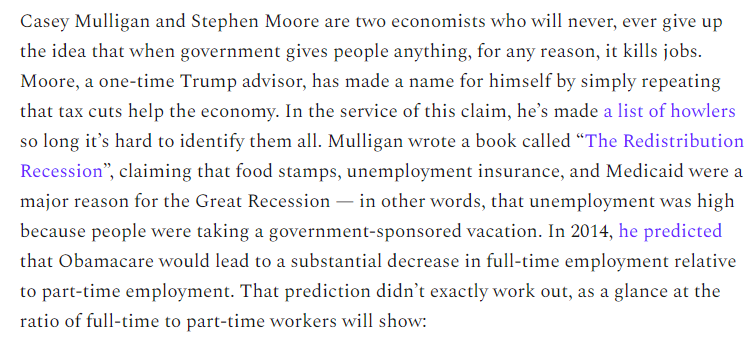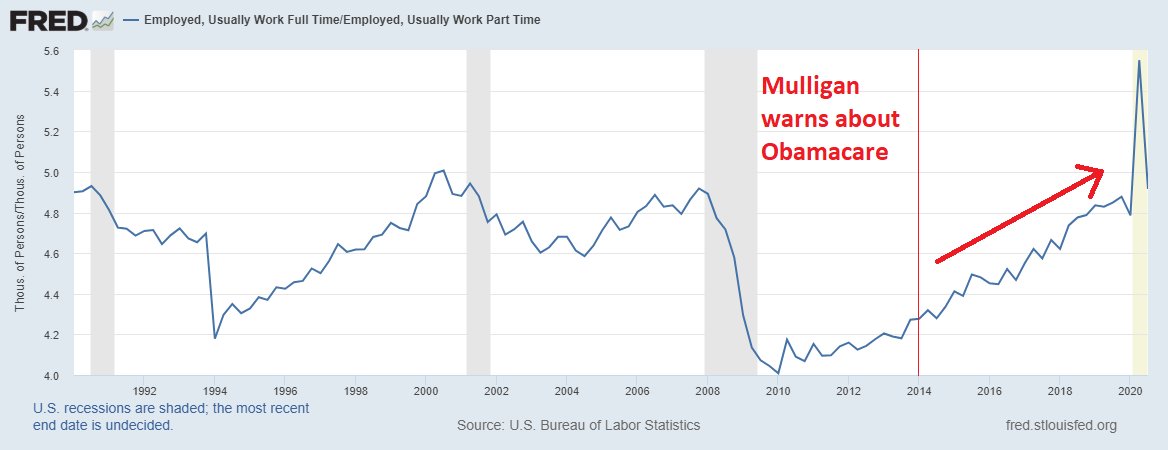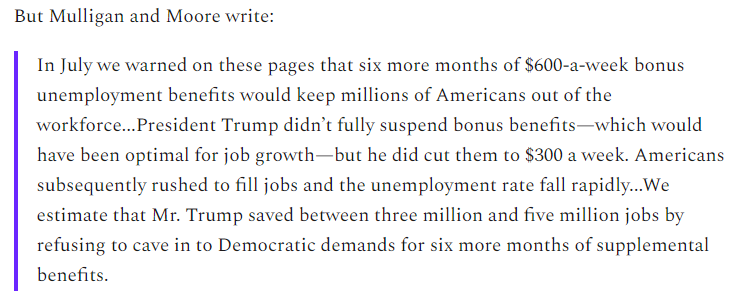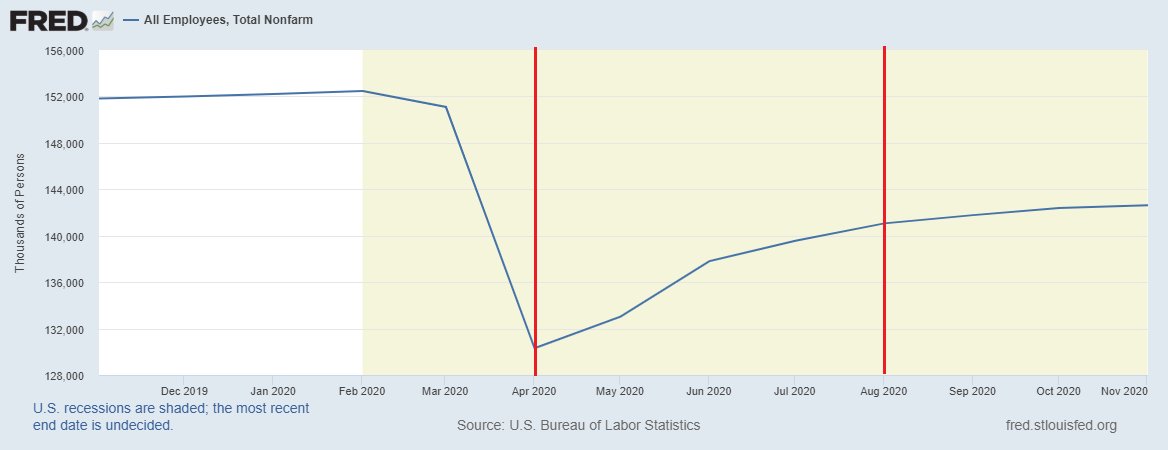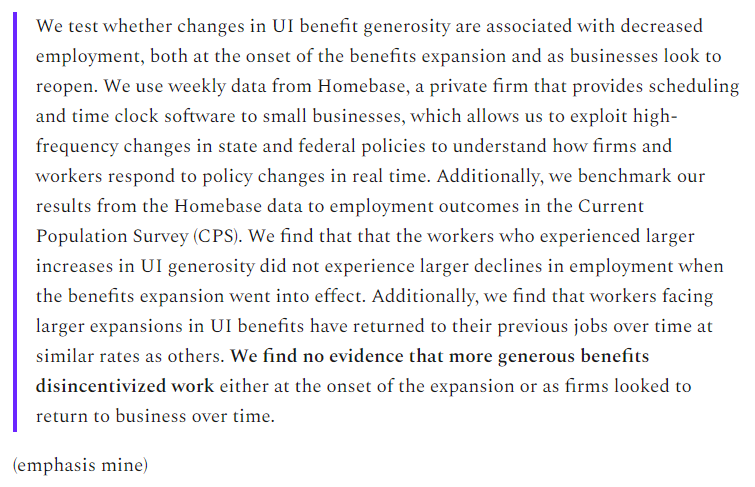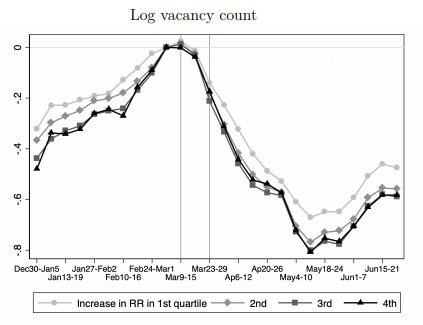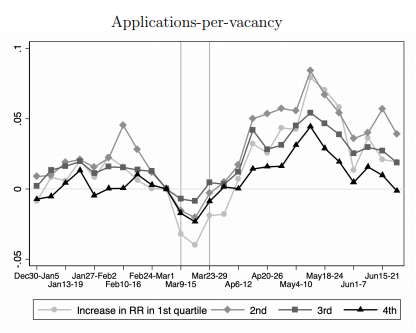1/OK, here's a thread of my latest blog post, in which I debunk an op-ed by Stephen Moore and Casey Mulligan claiming that Pandemic UI killed millions of jobs.
In fact, Pandemic UI didn't kill jobs. https://noahpinion.substack.com/p/no-pandemic-ui-didnt-kill-jobs
In fact, Pandemic UI didn't kill jobs. https://noahpinion.substack.com/p/no-pandemic-ui-didnt-kill-jobs
2/It's kind of goofy to have to debunk each of these bad arguments as they come up, because guys like Mulligan and Moore will just never, ever stop coming with them.
It's their job AND their life's calling to write bad arguments claiming that activist government kills jobs.
It's their job AND their life's calling to write bad arguments claiming that activist government kills jobs.
3/OK, anyway, on to Pandemic UI. That was the $600/week benefit that unemployed Americans got from April through July of 2020.
We have evidence that it decreased poverty ( https://bfi.uchicago.edu/wp-content/uploads/BFI_WP_202084.pdf)
and boosted consumption
( https://www.jpmorganchase.com/institute/research/labor-markets/report-consumption-effects-of-unemployment-insurance-during-the-covid-19-pandemic)
We have evidence that it decreased poverty ( https://bfi.uchicago.edu/wp-content/uploads/BFI_WP_202084.pdf)
and boosted consumption
( https://www.jpmorganchase.com/institute/research/labor-markets/report-consumption-effects-of-unemployment-insurance-during-the-covid-19-pandemic)
4/But Mulligan and Moore write that Pandemic UI killed literally MILLIONS of jobs, by paying workers to stay home.
5/So that's a bit of a weird claim, given that employment rose from April to August and then flattened out.
I mean technically it's POSSIBLE, but this isn't what you'd expect to see from a job-killing policy or its expiration.
I mean technically it's POSSIBLE, but this isn't what you'd expect to see from a job-killing policy or its expiration.
6/OK so let's look at some evidence.
Here's a paper by Altonji et al., finding no effect of Pandemic UI on employment.
https://tobin.yale.edu/sites/default/files/files/C-19%20Articles/CARES-UI_identification_vF(1).pdf
Here's a paper by Altonji et al., finding no effect of Pandemic UI on employment.
https://tobin.yale.edu/sites/default/files/files/C-19%20Articles/CARES-UI_identification_vF(1).pdf
7/Here are papers by @TimBartik et al., @arindube et al., and @ernietedeschi finding the exact same thing: Pandemic UI didn't decrease employment.
1. https://papers.ssrn.com/sol3/papers.cfm?abstract_id=3633053
2. https://www.dropbox.com/s/q0kcoix35jxt1u4/UI_Employment_HPS.pdf?dl=0
3. https://drive.google.com/file/d/1pFNyBJ4t7b3f5EOcm0BLcZyxRCOx4wWq/view
1. https://papers.ssrn.com/sol3/papers.cfm?abstract_id=3633053
2. https://www.dropbox.com/s/q0kcoix35jxt1u4/UI_Employment_HPS.pdf?dl=0
3. https://drive.google.com/file/d/1pFNyBJ4t7b3f5EOcm0BLcZyxRCOx4wWq/view
8/OK, so against all these papers, what evidence do Mulligan and Moore have to say that Pandemic UI killed jobs?
They literally just look at job openings.
They claim that job openings rose under Pandemic UI and fell afterward. And they think this proves their case...
They literally just look at job openings.
They claim that job openings rose under Pandemic UI and fell afterward. And they think this proves their case...
9/First of all, why you would look at just job openings and not at JOBS THEMSELVES mystifies me.
Also, they gloss over the fact that job openings PLUNGED during the first month of Pandemic UI, then rose moderately afterward.
Also, they gloss over the fact that job openings PLUNGED during the first month of Pandemic UI, then rose moderately afterward.
10/That last graph is from a paper by @mioana et al.
https://papers.ssrn.com/sol3/papers.cfm?abstract_id=3664265
The paper also measures how many applicants were actually looking for each job. They find that applicants per vacancy ROSE during Pandemic UI.
https://papers.ssrn.com/sol3/papers.cfm?abstract_id=3664265
The paper also measures how many applicants were actually looking for each job. They find that applicants per vacancy ROSE during Pandemic UI.
11/Remember, Mulligan and Moore's story is that an increase in job vacancies means no one wants to work. But if applicants per vacancy goes up, it means people DO want to work!
Mulligan and Moore's evidence is just ridiculous.
Mulligan and Moore's evidence is just ridiculous.
12/So Mulligan and Moore are wrong. Pandemic UI didn't kill jobs.
But now you may be asking: Why not? How can you pay people more than they could make at a job, and NOT convince people to stay home?
Well, I shall tell you...
But now you may be asking: Why not? How can you pay people more than they could make at a job, and NOT convince people to stay home?
Well, I shall tell you...
13/The key is that a job lasts a long time, while Pandemic UI does not (even if we had extended it). It's worth hanging on to a job if you have one, or getting one if you can, since otherwise you'll be screwed when Pandmemic UI ends.
14/This is explained in a great theory paper by Boar and @Simon_Mongey:
http://www.simonmongey.com/uploads/6/5/6/6/65665741/boar_mongey_cares_act_2020.pdf
http://www.simonmongey.com/uploads/6/5/6/6/65665741/boar_mongey_cares_act_2020.pdf
15/A PERMANENT Pandemic UI would almost certainly kill jobs. A TEMPORARY one -- i.e., the one that actually existed, and which we should have extended for a few months -- did not.
16/Anyway, it was silly that I had to debunk this stuff.
BUT, it gave me a chance to collect the theory and evidence about Pandemic UI in one place, which is useful!
So use this post as a reference if anyone tells you Pandemic UI was bad!
(end) https://noahpinion.substack.com/p/no-pandemic-ui-didnt-kill-jobs
BUT, it gave me a chance to collect the theory and evidence about Pandemic UI in one place, which is useful!
So use this post as a reference if anyone tells you Pandemic UI was bad!
(end) https://noahpinion.substack.com/p/no-pandemic-ui-didnt-kill-jobs
By the way, a correction: I tagged the wrong Bartik in my thread! The actual author of the paper in question was @AlexBartik, not @TimBartik!
(Though Tim is also great!)
(Though Tim is also great!)

 Read on Twitter
Read on Twitter